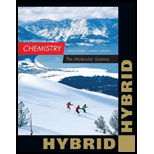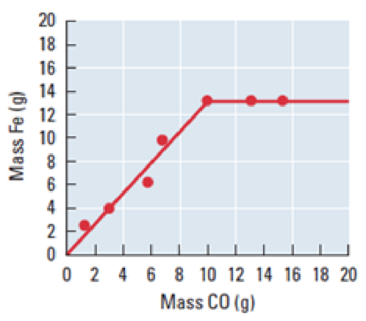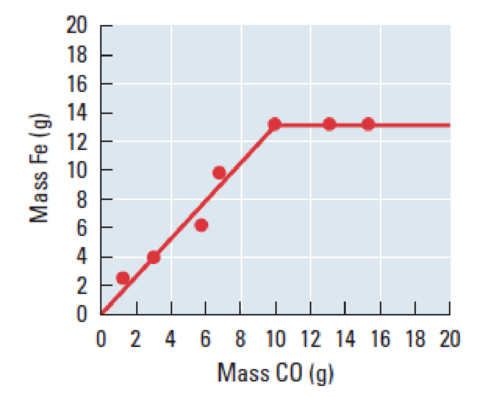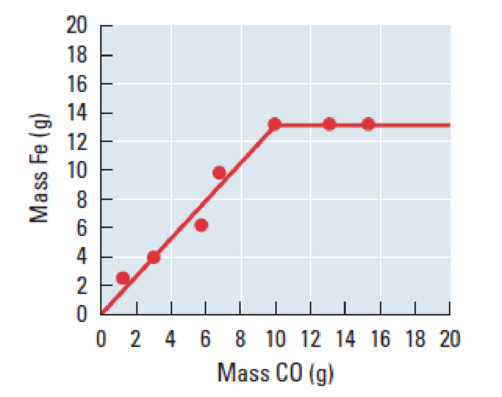
Concept explainers
In a blast furnace at high temperature, iron(III) oxide in ore reacts with carbon monoxide to produce metallic iron and carbon dioxide. The liquid iron produced is cooled and weighed. The reaction is run repeatedly with the same initial mass of iron(III) oxide, 19.0 g, but differing initial masses of carbon monoxide. The masses of iron obtained arc shown in this graph.

- (a) Write the balanced chemical equation for this reaction.
- (b) Calculate the mass of CO required to react completely with 19.0 g iron(III) oxide.
- (c) Calculate the mass of carbon dioxide produced when the reaction converts 10.0 g iron(III) oxide completely to products.
- (d) From the graph, determine which reactant is limiting when less than 10.0 g carbon monoxide is available to react with 19.0 g iron(III) oxide.
- (e) From the graph, determine which reactant is limiting when more than 10.0 g carbon monoxide is available to react with 19.0 g iron(III) oxide.
- (f) Calculate the percent yield if 24.0 g iron(III) oxide reacted with 20.0 g carbon monoxide to produce 15.9 g metallic iron.
- (g) Calculate the minimum mass of additional limiting reactant required to react with all of the excess of nonlimiting reactant from part (f).
(a)
Interpretation:
Iron
For the given reaction, balanced equation has to be written.
Concept introduction:
Balanced Chemical equation:
A balanced chemical equation is an equation which contains same elements in same number on both the sides (reactant and product side) of the chemical equation thereby obeying the law of conservation of mass.
Balancing the equation:
- There is a Law for conversion of mass in a chemical reaction i.e., the mass of total amount of the product should be equal to the total mass of the reactants.
- First write the skeletal reaction from the given information.
- Then count the number of atoms of each element in reactants as well as products.
- Place suitable coefficients in front of reactants as well as products until the number of atoms on each side (reactants and products) becomes equal.
Explanation of Solution
Given,
While balancing the equation, the subscripts cannot be altered but coefficients can be changed. There are two iron atoms in the left side and one iron atom in the right side of the reaction. Therefore, two iron atoms are added to right side of reaction. Now, the balanced equation is given below.
Three molecule of carbon monoxide is added to the left side of the reaction and three molecules of carbon dioxide is added to the right side of the reaction. Now, the balanced equation is given below.
(b)
Interpretation:
Mass of
Explanation of Solution
Given,
The molar mass of
According to the balancing equation, one mole of
Therefore, mass of
Mass of
(c)
Interpretation:
Mass of carbon dioxide produced when the reaction converts
Explanation of Solution
Given,
The molar mass of
According to the balancing equation, one mole of
Therefore, mass of
Mass of
(d)
Interpretation:
When less than
Concept introduction:
A limiting reactant is a reactant that is completely converted to products. Once all the limiting reactant is converted to products there is no other reactant to react.
Explanation of Solution
Given,

Figure 1
One mole of
The given graph between the mass of Fe and mass of carbon monoxide. The graph tells that the weight of the carbon monoxide is below
The calculation, shows that
(e)
Interpretation:
When more than
Concept introduction:
Refer to part (d)
Explanation of Solution
Given,

Figure 1
One mole of
The given graph between the mass of Fe and mass of carbon monoxide. The graph tells that the weight of the carbon monoxide is below
The graph tells that the weight of the carbon monoxide is more than
The calculation,
(f)
Interpretation:
When 24.0 g iron
Concept introduction:
The percent yield can be calculated by using following formula
Explanation of Solution
Given,
The molar mass of
According to the balancing equation, one mole of
Given,
Number of moles of iron is calculated as follows,
Number of moles of iron is calculated as follows,
According to the mole calculation,
Amount of
The percent yield can be calculated by using following formula
The percent yield is
(g)
Interpretation:
The minimum mass of additional limiting reactant necessary to react with all of the excess of non-limiting reactant has to be calculated.
Explanation of Solution
Given,
The molar mass of
According to the balancing equation, one mole of
Given,
Number of moles of iron is calculated as follows,
Number of moles of iron is calculated as follows,
According to the mole calculation,
Gram of
Want to see more full solutions like this?
Chapter 3 Solutions
Chemistry: The Molecular Science, Hybrid Edition (with OWLv2 24-Months Printed Access Card)
- A titanium ore contains rutile (TiO2) plus some iron oxide and silica. When it is heated with carbon in the presence of chlorine, titanium tetrachloride, TiCl4, is formed. TiO2(s)+C(s)+2Cl2(g)TiCl4(g)+CO2(g) Titanium tetrachloride, a liquid, can be distilled from the mixture. If 35.4 g of titanium tetrachloride is recovered from 18.1 g of crude ore, what is the mass percentage of TiO2 in the ore (assuming all TiO2 reacts)?arrow_forwardSilicon is produced for the chemical and electronics industries by the following reactions. Give the balanced equation for each reaction. a. SiO2(s)+C(s)arefurnaceElectricSi(s)+CO(g) b. Liquid silicon tetrachloride is reacted with very pure solid magnesium, producing solid silicon and solid magnesium chloride. c. Na2SiF6(s) + Na(s) Si(s) + NaF(s)arrow_forwardThe pictures below show a molecular-scale view of a chemical reaction between the compounds AB2 and B2. (Green balls represent B atoms and orange balls are A atoms). The box on the left represents the reactants at the instant of mixing, and the box on the right shows what is left once the reaction has gone to completion. Was there a limiting reactant in this reaction? If so, what was it? Write a balanced chemical equation for this reaction. As usual, your equation should use the smallest possible whole number coefficients for all substances.arrow_forward
- Bacterial digestion is an economical method of sewage treatment. The reaction is an intermediate step in the conversion of the nitrogen in organic compounds into nitrate ions. What mass of bacterial tissue is produced in a treatment plant for every 1.0 104 kg of wastewater containing 3.0% NH4+ ions by mass? Assume that 95% of the ammonium ions are consumed by the bacteria.arrow_forwardPropane, C3H8, is the fuel of choice in a gas barbecue. When burning, the balanced equation is C3H8+5O23CO2+4H2O a What is the limiting reactant in cooking with a gas grill? b If the grill will not light and you know that you have an ample flow of propane to the burner, what is the limiting reactant? c When using a gas grill you can sometimes turn the gas up to the point at which the flame becomes yellow and smokey. In terms of the chemical reaction, what is happening?arrow_forward4.16 Many metals react with halogens to give metal halides. For example, iron reacts with chlorine to give iron(II) chloride, FeCl2: Fe(s)+Cl2(g)FeCl2(s) Beginning with 10.0 g iron, what mass of Cl2, in grams, is required for complete reaction? What quantity of FeCl2, in motes and in grams, is expected?arrow_forward
- 3.115 The average person exhales 1.0 kg of carbon dioxide in a day. Describe how you would estimate the number of CO2 molecules exhaled per breath for this average person.arrow_forward3.105 Nitric acid is often sold and transported as a concentrated 16 M aqueous solution. How many gallons of such a solution would be needed to contain the roughly 2.1109 pounds of HNO3 produced annually in the United States?arrow_forwardCopper reacts with nitric acid according to the following reaction. 3Cu(s)+8HNO3(aq)3Cu(NO3)2(aq)+2NO(g)+4H2O(l) If 2.40 g of Cu is added to a container with 2.00 mL of concentrated nitric acid (70% by mass HNO3; density = 1.42 g/cm3), what mass of nitrogen monoxide gas will be produced?arrow_forward
- 4.24 Ammonia gas can be prepared by the reaction CaO(s)+2NH4Cl(s)2NH3(g)+H2O(g)+CaCl2(s) If 112 g of CaO reacts with 224 g of NH4Cl, how many moles of reactants and products are there when the reaction is complete?arrow_forward4.108 Elemental analysis is sometimes carried out by combustion of the sample. For a hydrocarbon, the only products formed are CO2 and H2O. If a 1.36-g sample of an unknown hydrocarbon is burned and 2.21 g of H2O is produced along with 4.07 g of CO2, what is the empirical formula of the hydrocarbon?arrow_forwardThe balanced equation for the reduction of iron ore to the metal using CO is Fe2O3(s) + 3 CO(g) 2 Fe(s) + 3 CO2(g) (a) What is the maximum mass of iron, in grams, that can be obtained from 454 g (1.00 lb) of iron(III) oxide? (b) What mass of CO is required to react with 454 g cot Fe2O3?arrow_forward
 World of ChemistryChemistryISBN:9780618562763Author:Steven S. ZumdahlPublisher:Houghton Mifflin College Div
World of ChemistryChemistryISBN:9780618562763Author:Steven S. ZumdahlPublisher:Houghton Mifflin College Div World of Chemistry, 3rd editionChemistryISBN:9781133109655Author:Steven S. Zumdahl, Susan L. Zumdahl, Donald J. DeCostePublisher:Brooks / Cole / Cengage Learning
World of Chemistry, 3rd editionChemistryISBN:9781133109655Author:Steven S. Zumdahl, Susan L. Zumdahl, Donald J. DeCostePublisher:Brooks / Cole / Cengage Learning Chemistry for Engineering StudentsChemistryISBN:9781285199023Author:Lawrence S. Brown, Tom HolmePublisher:Cengage Learning
Chemistry for Engineering StudentsChemistryISBN:9781285199023Author:Lawrence S. Brown, Tom HolmePublisher:Cengage Learning Chemistry for Engineering StudentsChemistryISBN:9781337398909Author:Lawrence S. Brown, Tom HolmePublisher:Cengage Learning
Chemistry for Engineering StudentsChemistryISBN:9781337398909Author:Lawrence S. Brown, Tom HolmePublisher:Cengage Learning ChemistryChemistryISBN:9781305957404Author:Steven S. Zumdahl, Susan A. Zumdahl, Donald J. DeCostePublisher:Cengage Learning
ChemistryChemistryISBN:9781305957404Author:Steven S. Zumdahl, Susan A. Zumdahl, Donald J. DeCostePublisher:Cengage Learning





